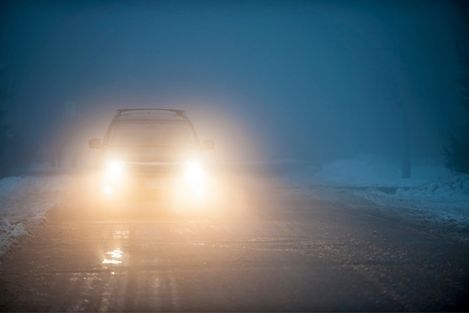
Written by Kayla Jane Barrie Updated on Feb 21, 2025 4 mins read

Did you know that there is an increased risk of collision due to low visibility during fog?
On average, there are over 25,000 crashes and close to 500 deaths from driving in fog. MTO advises against driving in fog, but sometimes it can’t be avoided, or it happens while you are already on the road. Staying safe means you need to make adjustments to your driving and the reduced visibility with fog.
It’s a common myth that if an accident happens during inclement weather, no one is at-fault. No matter the weather, you are expected to take safety precautions. Here is how to be a safe driver when the fog rolls in.
When driving in fog, it is suggested to use your low beams, not high beams. Most vehicles come with fog lights specifically designed to shine below the fog line (20-24 inches from the ground). This helps the lights from reflecting off the water particles, unlike regular headlights, which are higher and reflect more.
Although fog lights will not light up the road more, they allow you to see the road clearer and make driving in fog safer. Your vehicle will also be more visible to other drivers.
A common debate is whether LED fog lights are better than halogen. LED tends to be more expensive, but they last much longer – halogen often lasts 18-24 months, compared to years for LED. The white light can also pierce through fog much stronger than the yellow lights from Halogen.
If you have LED lights, remember they can cause more glare in fog. When you are doing car maintenance, check to see if your fog lights are positioned correctly to work to their optimal ability. Keep in mind these fixes will likely not be covered under your Ontario auto insurance.
It’s not only driving in winter where roads can become hazardous. Fog can appear on roads when the warm air makes contact with the cooler surface air. When driving in autumn or spring, you may be faced with fog covered roads. This occurrence is common around the Great Lakes and low areas.
Although you can’t control the weather, there are many safety tips to keep in mind when driving in the fog. Here are 12 things to keep in mind if you need to drive in fog:
If the conditions become too much, use your signal, pull off to the side of the road and wait it out. If there is a service center or parking lot nearby, consider stopping there. Turn on your hazards and keep your lights on. Never stop in the middle of the road.
If you do experience an accident, brush up on how to file a car insurance claim.
When driving in the fog, it can be helpful to remember to avoid these three things :
If you have to drive in fog, slow down and turn on your lights and fog lights if you have them installed with your car.
Ensure your windows and mirrors are clear, use low beams or fog lights, and use the right pavement painting as a guide.
Fog drastically limits how far drivers can see. It is crucial to slow down, drive without distractions, and do not use your high beams.
Along with practicing safe driving, it's important to make sure your car insurance quote will adequately protect you if there is an accident while driving.
| Categories | Auto |
|---|---|
| Tags | Driving Tips |
Read our insurance blog to get helpful tips, information and news.
Has your car been totalled in an accident? Is your car a write off? Learn about vehicle write offs for a total loss insurance claim.
Get the facts on Toronto's auto theft problem. We break down the data, reveal the most-stolen vehicles (including the Honda CR-V and Lexus RX 350), and show which neighbourhoods are most affected.
Dive into the world of auto theft with our blog on the most stolen cars in Canada. See the most stolen cars across Canada, including provincial lists for Ontario and Quebec, and learn how high-risk models can affect your car insurance premiums.
Drive safe this winter! Check out these tips for driving in snowy and icy conditions in Ontario. Get other helpful info and FAQs on winter driving.